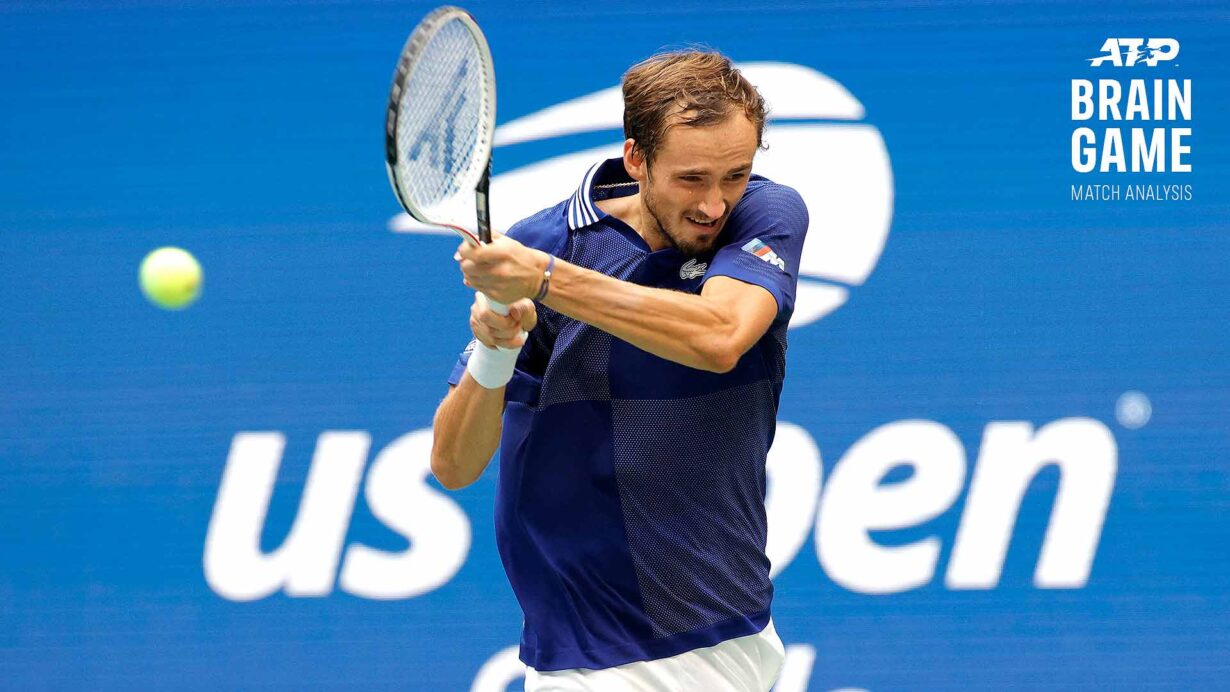

Novak Djokovic needed forehands. He settled for backhands. The rest is history.
Daniil Medvedev defeated Djokovic 6-4, 6-4, 6-4 in the US Open final Sunday evening in New York, stopping the Serb from being the first player since Rod Laver in 1969 to win all four majors in a season. Making Djokovic’s forehand a non-factor in the final was the strategic engine room of the stunning victory.
Medvedev’s cunning plan was to overload the Ad court with a plethora of backhand-to-backhand exchanges, where he could neutralise and torment Djokovic with his ultra-flat backhand that proved extremely difficult to attack. It worked in spades. Djokovic ended up hitting more backhand groundstrokes than forehand groundstrokes for the match.
Total Groundstrokes (excluding returns, volleys & overheads)
- Novak Djokovic
- Total Forehands = 43% (122)
- Total Backhands = 57% (161)
Surprisingly, Djokovic ended up hitting 39 more backhands than forehands for the match. As a comparison, when Djokovic defeated Stefanos Tsitsipas in the quarter-finals of the Rome Masters 1000 this year (4-6, 7-5, 7-5), he hit 58 per cent (266) forehands and 42 per cent (194) backhands.
Djokovic is partly to blame for the overload of backhands against Medvedev, as there were dozens of balls he could have hit a run-around forehand instead of a backhand. He either chose not to upgrade the stroke, did not fully comprehend Medvedev’s maddening strategy, or didn’t have enough gas left in the legs to seize the opportunity.
Medvedev struck almost triple the number of groundstroke winners (16-6) in the match while committing fewer errors overall (33-38).
- Novak Djokovic
- Winners = Forehand 3 / Backhand 3
- Errors = Forehand 18 / Backhand 20
- Daniil Medvedev
- Winners = Forehand 11 / Backhand 5
- Errors = Forehand 16 / Backhand 17
All tournament, Djokovic didn’t show his typical thirst to upgrade to a run-around forehand over a backhand standing in the Ad court. He was content to go toe-to-toe with opponents banging backhands back and forth. That strategy helped get him to the final, but it wasn’t a winning game plan against Medvedev’s menacing backhand, which gives you nothing to work with.
Djokovic Run-Around Forehands (Standing in the Ad court)
- Total = 47 (39% of total forehands)
- Ball came back in play = 38 (81%)
- Winners = 1
- Errors = 4
- Forced an error = 4
Djokovic hit 39% of total forehands as a run-around in the Ad court, but they were not the lethal blows we are used to seeing from the Serb. He only struck one winner from a run-around forehand in three sets while committing four errors. More than 80 percent came back in play, rendering this normally potent tactic insignificant in the final outcome.
Djokovic hit only six groundstroke winners in 283 shots, which averages at one winner every 47 shots. That’s not the Novak Djokovic that won three majors this year. Medvedev hit 16 groundstroke winners from 295 shots, which averages as one winner every 18 shots. Medvedev clearly turned the baseline into his playground in the final.
Game plans can succeed, fail, or get lost in the wash and dissolve in a player’s mind in the heat of battle. Once Djokovic reacted emotionally to not breaking Medvedev when leading 0-40 at 0-1 in the second set, and failed to convert two break points in the following service game, the clarity needed to find a winning game plan vanished.
In the second set, Djokovic hit just 39 per cent (46) forehands and 61 per cent (73) backhands. That was good for just one groundstroke winner and 15 errors. Djokovic had defining moments of tactical lucidity after losing the opening set in his four previous matches in New York. That mental strength proved to be a bridge too far in the final.
In the 2021 Australian Open final, Djokovic defeated Medvedev by mauling his forehand. Medvedev committed seven forehand errors in the first three games of the final. The Russian only committed four in the entire first set in New York last night.
Ultimately, Medvedev attained victory because Djokovic did not copy and paste a winning strategy from Melbourne in January as well as not being able to diffuse Medvedev’s Ad court dominated backhand strategy with run-around forehands. In the end, Medvedev made Djokovic bend to his intentions, having to contend with ultra-flat backhand knuckleballs in endless, backhand-to-backhand exchanges.






